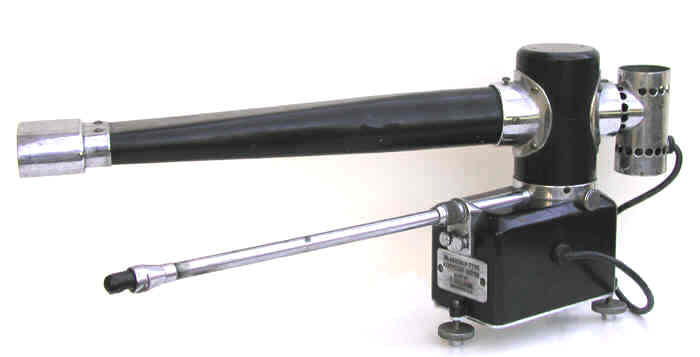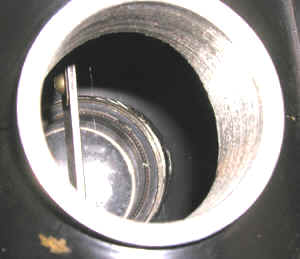String Electrometer of Carl Braestrup (1930s, early 1940s)

This electrometer was produced for Carl Braestrup, probably in the 1930s. A picture of it appears in his paper "X-ray Protection in Diagnostic Radiology" that appeared in the February 1942 issue of Radiology (p. 207-216). It was used to measure the charge on a condenser-type thimble ion chamber before and after a radiation exposure in an x-ray beam. The decrease in the charge was related to the exposure via a calibration.
In the previously referenced paper, it is described as a “modified Wulf type r-meter” which would imply that the fiber was suspended between two identical plates of opposite charges. However, on inspection it appears to be more of a modified Wulf electroscope.

In the above photo, the small black thimble chamber is seen at the end of a 16" long chrome-plated probe. The black viewing tube and the thimble probe, both pointing in the same direction (towards the left), can be rotated independently. The chrome cylinder with the holes in it on the right of the unit is a protective housing for the light bulb. The metal plate on the end of the meter says "Braestrup type Roentgen Meter, Made by F. Sellmer, Brooklyn New York."
Carl B. Braestrup (1897-1982) was born in Copenhagen Denmark. He worked as an engineer at Bell Telephone Laboratories and Picker X-ray Corporation, instructed at the Post Graduate Medical School of Columbia University, and served as the Director of the Physics Laboratory of the New York City Department of Hospitals. In the 1930s, he was one of the first to develop a film badge that would account for the energy of the radiation and he was also one of the first ten persons certified in X-ray physics by the Radiological Society of North America. An internationally recognized expert on shielding design, he developed a standardized approach to shielding design for medical and industrial X-ray facilities. This methodology that formed the basis of the NCRP 49 protocols. Together with Harold Wyckoff, he coauthored the classic textbook Radiation Protection (1958).
Donated by Richard Mooney.
